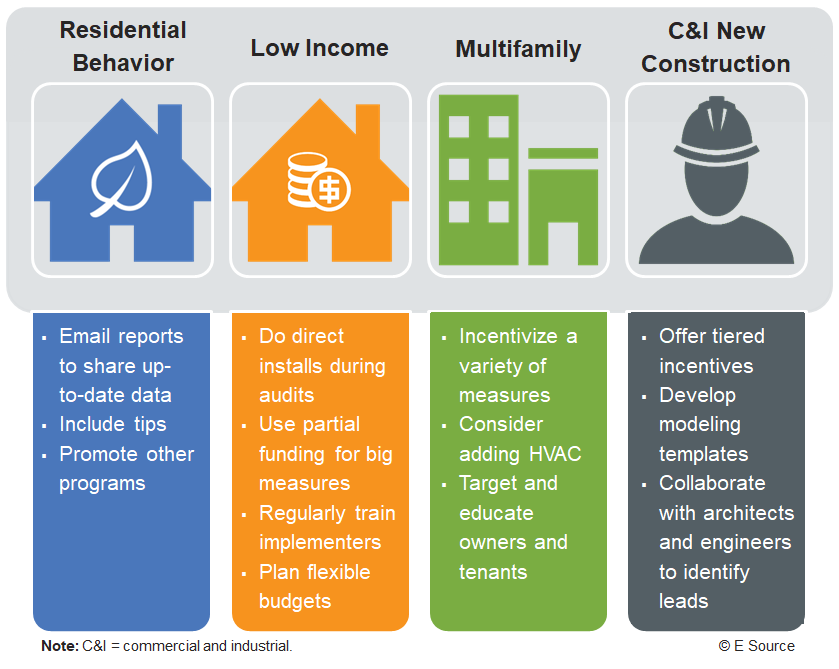Lighting measures traditionally have been the most cost-effective component of energy-efficiency programs because they’re easy to install and provide high savings at a low cost. With the removal of lighting from programs, utilities are looking for new measures and strategies to maintain cost-effectiveness. As part of the E Source series on the “Next generation of energy savings,” we’ve identified program-specific best practices from some of the most cost-effective programs across four core program types: residential behavior, low income, multifamily, and commercial and industrial (C&I) new construction (Figure 1).
Figure 1: Tips for improving cost-effectiveness by program type
Best-in-class programs based on TRC values
For our analysis, we selected four core program types—residential behavior, low income, multifamily, and C&I new construction—and identified one high-performing program within each program type based on total resource cost (TRC) values. We then reviewed program plans and evaluations to understand which strategies contribute most to cost-effectiveness. The programs we highlight here have found success by developing efficient processes, forming partnerships, and integrating nonlighting measures.
We gathered TRC information using DSM Insights, which contains data on demand-side management (DSM) program goals, budgets, spending, and savings from DSM regulatory filings. We consider a TRC value at or above 1.0 to be cost-effective. The higher the number, the greater the cost-effectiveness. Figure 2 shows TRC values from 2010 through 2016 for each program type.
Figure 2: Cost-effectiveness by utility and program type, 2010–2016
|
TRC values
|
||||
|---|---|---|---|---|
| Year | PPL Electric Utilities’ behavior program | Otter Tail Power Co.’s low-income program | Entergy Arkansas’s multifamily program | National Grid MA’s C&I new-construction program |
| Note: C&I = commercial and industrial; TRC = total resource cost. | © E Source; data from utility annual reports and regulatory filings | |||
| 2010 | 1.57 | 2.13 | 3.75 | 3.94 |
| 2011 | 1.69 | 2.51 | 3.32 | 5.43 |
| 2012 | 1.64 | 2.46 | 1.87 | 3.00 |
| 2013 | 1.87 | 1.24 | 2.15 | 3.74 |
| 2014 | 1.46 | 2.87 | 2.29 | 2.32 |
| 2015 | 2.33 | 1.07 | 1.53 | 1.54 |
| 2016 | 3.90 | 1.90 | 1.83 | 2.52 |
In the sections that follow, we provide details on each program and highlight strategies you can use to boost the cost-effectiveness of your programs.
Residential behavior
PPL Electric Utilities’ personalized home energy report (HER) includes energy-consumption data, a neighbor comparison, and three energy-saving tips. The utility uses the tips section to promote its DSM programs: appliance recycling, residential retail in-store equipment discounts, and the Residential Home Comfort audit and rebate program.
In 2014, four years after launching the program, PPL began emailing monthly HERs in addition to the postal mail version. The emailed report consists primarily of the neighbor comparison to provide a more timely usage picture. Around the same time as the addition of emailed reports, PPL changed the look and feel of the report to be more personalized and added a clear explanation of how neighbor comparisons are made. As a result of these changes, PPL has anecdotal evidence of a drop in the HER program opt-out rates.
Low income
Otter Tail Power Co.’s House Therapy program for low-income customers maintains cost-effectiveness by offering multiple efficiency options during the in-home audit and by actively engaging with its community action agency implementers. The utility maximizes savings opportunities and reduces costs by offering free direct-install energy-saving measures while the auditor is already in the home.
Cost-sharing can be another useful way to maintain high cost-effectiveness while providing needed customer assistance.
In addition to installing these low-cost measures at no cost to customers, Otter Tail Power provides qualifying customers with an electric water heater if they participate in an off-peak rate as well as an energy-efficient refrigerator. The utility also splits the cost of an electric water heater (on an off-peak rate) or refrigerator with rental unit owners. Water heaters and refrigerators may cost more than other measures, but they can also lead to greater savings. Cost-sharing can be another useful way to maintain high cost-effectiveness while providing needed customer assistance.
Otter Tail Power has built strong relationships with its community action agency implementers, which has helped the program run more smoothly and efficiently. The utility hosts yearly trainings for community action agency office and field staff to provide continuous education about the program and build rapport.
Finally, the utility ensures that its program managers use their funds effectively by building flexibility into program budgets. For example, if one community action agency is not going to use all of the money allocated to its projects in a given year, the utility can reassign funds to another agency that has capacity for additional work. This ensures that all available dollars go toward energy savings.
Multifamily
In 2015, the Energy Solutions Multifamily Program at Entergy Arkansas provided no-cost direct-install measures and cost-effective prescriptive measures. The next year, the utility added air-conditioner (AC) tune-ups, duct sealing, and air sealing to the program, which contributed to an increase in cost-effectiveness from a 0.99 TRC value in 2015 to 6.09 in 2016. After the program changes, AC tune-ups have contributed 65% of program savings, while lighting contributes just 15%. These HVAC measures provide an opportunity for cost-effective, nonlighting energy savings.
The program targets multifamily property owners, landlords, and tenants to increase engagement and participation. By providing informational leave-behind cards for tenants and summary reports on property and common-area measures for landlords, Entergy Arkansas educates these customers about the benefits of installing energy-efficiency measures.
C&I new construction
ComEd’s C&I new-construction program offers a tiered incentive structure that drives participation and accommodates all types of new-construction projects. This flexibility mitigates the challenges of rising building codes, the advancing pace of project delivery, and the high costs of modeling.
By developing online templates for multiple building types, ComEd has created an expedited modeling process that saves time and money.
The program includes three tiers: a prescriptive tier, a custom tier, and an accelerated performance tier. New-construction projects that lack funds for modeling or analyses can go through the prescriptive offering and use a modeling template for the customer’s building type. By developing online templates for multiple building types, ComEd has created an expedited modeling process that saves time and money. The custom tier accommodates more-in-depth projects that can afford some custom modeling. The accelerated performance tier, a partnership with the US Department of Energy and Seventhwave, offers higher performance-based incentives than the other tiers in exchange for more savings.
ComEd offers trainings to educate the architectural and engineering communities about the utility’s new-construction program. These groups are then able to provide leads for the utility’s project pipeline, which saves the utility time and money in identifying projects.
Making These Best Practices Work for You
These best practices from leading cost-effective programs can help your utility transition to the next generation of energy savings. Developing cost-effective energy-efficiency programs in a postlighting world does not have to mean creating brand-new programs for your utility. By adding new measures to existing programs, identifying process improvements, and taking advantage of industry relationships, you can help build resilient, cost-effective programs that will carry you into the future.


